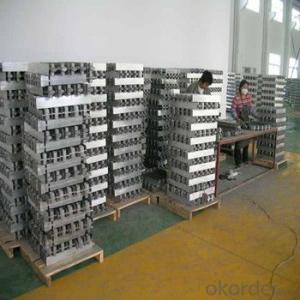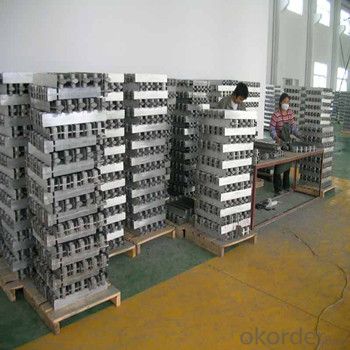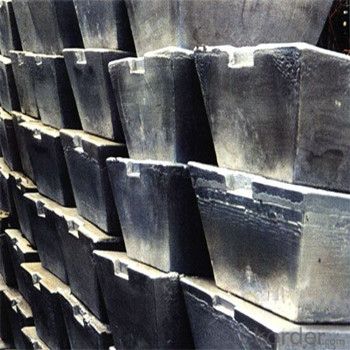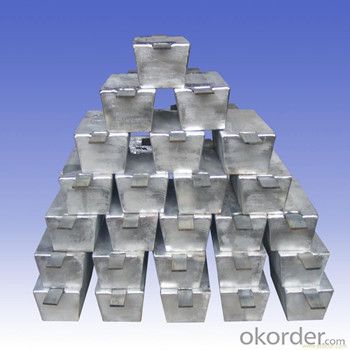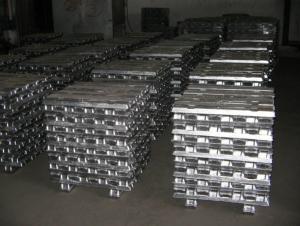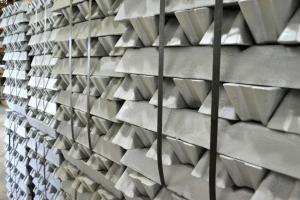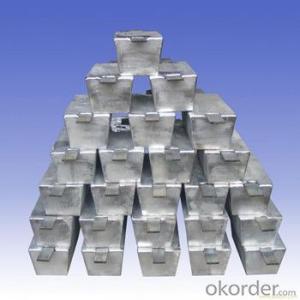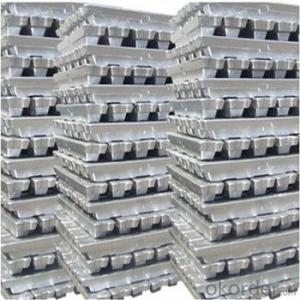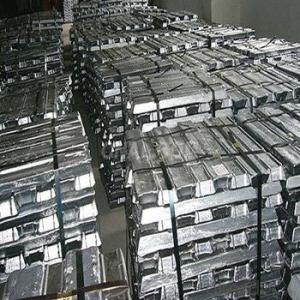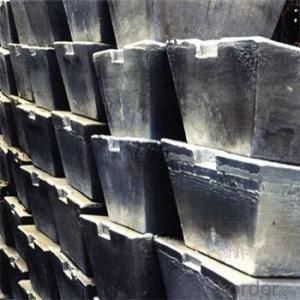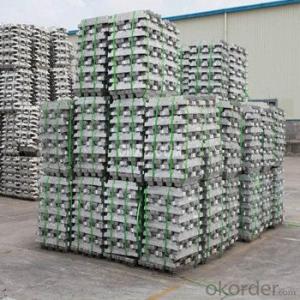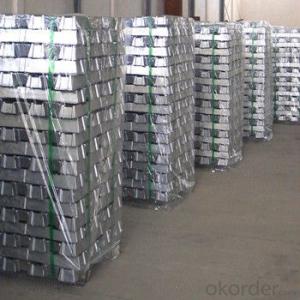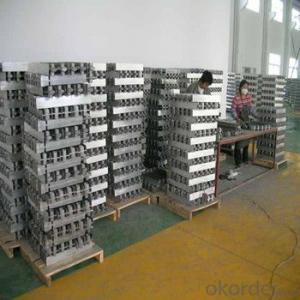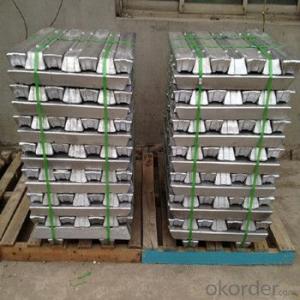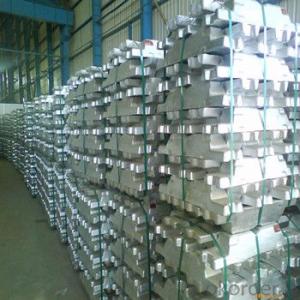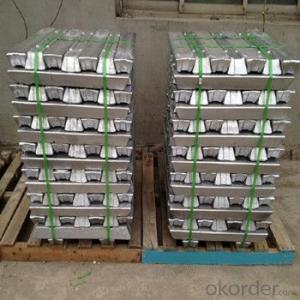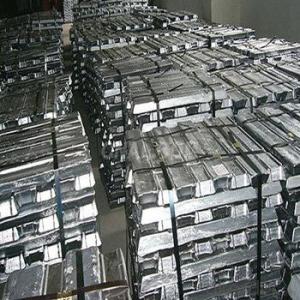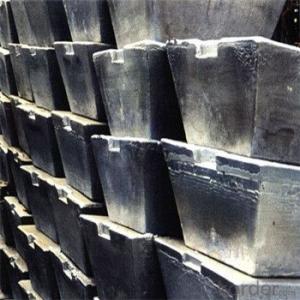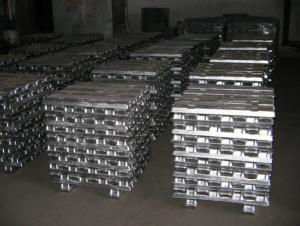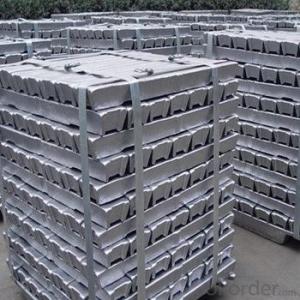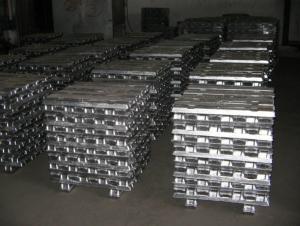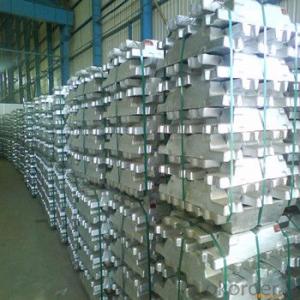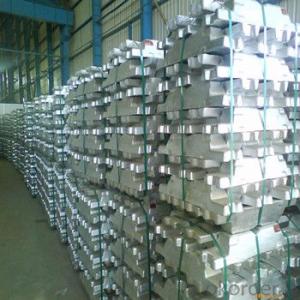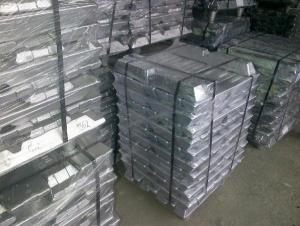Aluminium Ingot Al99.70 From Good Factory
- Loading Port:
- China main port
- Payment Terms:
- TT OR LC
- Min Order Qty:
- 1000 m.t.
- Supply Capability:
- 10000 m.t./month
OKorder Service Pledge
OKorder Financial Service
You Might Also Like
Pure Aluminum Ingot Used for Industry
1.Structure of Aluminum Ingot Description
A material that has been cast into a shape in order to be transported and processed easier than in an unprocessed form. An ingot is typically rectangular in shape, which allows it to be stacked. Ingots are most commonly associated with metals, with ingots of gold held in the vaults of banks and brokerages being popular images.
2.Main Features of the Aluminum Ingot
•High Purity
•High strength
•Fast melting
•Best price
•Good after-service
3. Aluminum Ingot Images
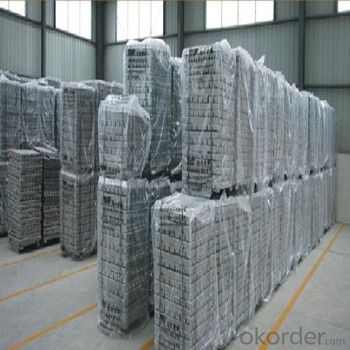
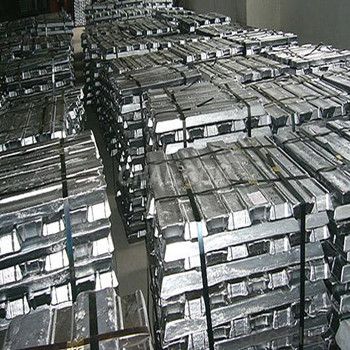
4. Aluminum Ingot Specification
Grade | Chemical Composition % | |||||||||
Al≥ | impurities ≤ | |||||||||
Si | Fe | Cu | Ga | Mg | Zn | Mn | others | Sum | ||
Al99.9 | 99.90 | 0.50 | 0.07 | 0.005 | 0.02 | 0.01 | 0.025 | - | 0.010 | 0.10 |
Al99.85 | 99.85 | 0.80 | 0.12 | 0.005 | 0.03 | 0.02 | 0.030 | - | 0.015 | 0.15 |
Al99.7 | 99.70 | 0.10 | 0.20 | 0.010 | 0.03 | 0.02 | 0.030 | - | 0.030 | 0.30 |
Al99.6 | 99.60 | 0.16 | 0.25 | 0.010 | 0.03 | 0.03 | 0.030 | - | 0.030 | 0.40 |
Al99.5 | 99.50 | 0.22 | 0.30 | 0.020 | 0.03 | 0.05 | 0.050 | - | 0.030 | 0.50 |
Al99.00 | 99.00 | 0.42 | 0.50 | 0.020 | 0.03 | 0.05 | 0.050 | - | 0.050 | 1.00 |
5.FAQ of Aluminum Ingot
We have organized several common questions for our clients,may help you sincerely:
①How about your company?
A world class manufacturer & supplier of castings forging in carbon steel and alloy steel,is one of the large-scale professional investment casting production bases in China,consisting of both casting foundry forging and machining factory. Annually more than 8000 tons Precision casting and forging parts are exported to markets in Europe,America and Japan. OEM casting and forging service available according to customer’s requirements.
②How to guarantee the quality of the products?
We have established the international advanced quality management system,every link from raw material to final product we have strict quality test;We resolutely put an end to unqualified products flowing into the market. At the same time, we will provide necessary follow-up service assurance.
③How long can we receive the product after purchase?
In the purchase of product within three working days, We will arrange the factory delivery as soon as possible. The pecific time of receiving is related to the state and position of customers.Commonly 7 to 10 working days can be served.
- Q: What is an aluminum ingot?
- An aluminum ingot is a solid block or bar of aluminum that has been cast or processed into a specific shape for storage, transportation, or further manufacturing purposes. It is typically obtained by melting aluminum and pouring it into a mold to solidify into a desired form. These ingots are commonly used as raw materials in various industries, including construction, automotive, aerospace, and electronics, where aluminum's lightweight, corrosion-resistant, and malleable properties are highly valued.
- Q: What kind of aluminum consumption does the furnace compare with natural gas?
- The aluminum loss of the reverberatory furnace is proportional to the melting time: the longer the loss is, the higher the temperature of the flame, the aluminum surface continues to oxidize to alumina powder.
- Q: What is the current market price of aluminum ingots?
- The current market price of aluminum ingots is subject to change and may vary depending on factors such as supply and demand, global economic conditions, and market fluctuations. To obtain the most accurate and up-to-date information on the current market price of aluminum ingots, it is recommended to consult reputable financial news platforms, commodity exchanges, or industry reports.
- Q: Can aluminum ingots be customized for specific applications?
- Yes, aluminum ingots can be customized for specific applications. Aluminum is a versatile material that can be alloyed with other elements to enhance its properties such as strength, corrosion resistance, and thermal conductivity. By carefully selecting the alloy composition and processing techniques, aluminum ingots can be tailored to meet the specific requirements of various applications ranging from automotive parts to aerospace components.
- Q: What is the lifespan of aluminum ingots?
- The durability and corrosion resistance of aluminum ingots make them suitable for long-term use, with their lifespan being influenced by factors such as storage conditions, handling practices, and environmental factors. When stored correctly and shielded from moisture and other corrosive elements, aluminum ingots can endure for several decades. They can maintain their structural integrity and physical properties over an extended period, rendering them valuable in various industries. In addition, aluminum ingots can be recycled and reused, further lengthening their lifespan. Through the recycling process, used aluminum products can be transformed back into ingots, which can then be employed in the production of new items. Overall, the longevity of aluminum ingots is relatively high, and with proper care and maintenance, they can fulfill their intended purpose for many years.
- Q: What are the advantages of using aluminum ingots in electrical applications?
- There are several advantages of using aluminum ingots in electrical applications. Firstly, aluminum is a lightweight material, which makes it easier to handle and transport. This property is particularly beneficial in electrical applications where weight is a concern, such as in the construction of power lines or in the manufacturing of electrical appliances. Secondly, aluminum has excellent electrical conductivity. It conducts electricity almost twice as well as copper, which is commonly used in electrical applications. This high conductivity allows for efficient transmission of electricity and reduces energy losses in electrical systems. Another advantage of aluminum ingots is their corrosion resistance. Aluminum forms a protective oxide layer when exposed to air, which helps to prevent corrosion. This makes aluminum suitable for use in outdoor electrical applications, where exposure to moisture or harsh weather conditions is common. Furthermore, aluminum is a highly recyclable material. It can be melted down and reused multiple times without losing its properties. This not only reduces the need for mining and extraction of new raw materials but also contributes to the sustainability of electrical applications. Lastly, aluminum ingots are cost-effective compared to other materials like copper or steel. Aluminum is abundant in nature and its extraction and processing are relatively less expensive, making it a more affordable option for electrical applications. Overall, the advantages of using aluminum ingots in electrical applications include their lightweight nature, high electrical conductivity, corrosion resistance, recyclability, and cost-effectiveness. These properties make aluminum a preferred choice in various electrical systems, contributing to improved efficiency, durability, and environmental sustainability.
- Q: How are aluminum ingots used in the automotive industry?
- Aluminum ingots are used in the automotive industry primarily for the production of lightweight components, such as engine blocks, cylinder heads, and body panels. This helps to improve fuel efficiency and overall vehicle performance, while also reducing emissions. Additionally, aluminum ingots are utilized in the manufacturing of transmission cases, suspension systems, and other structural parts, contributing to the overall strength and durability of vehicles.
- Q: Is it harmful to the human body to refine ingots from waste capacitors?
- The electrolyte here, not the electrolyte in the battery, must be made clear;
- Q: What is the average price of an aluminum ingot?
- The average price of an aluminum ingot can vary depending on various factors such as market conditions, supply and demand dynamics, and regional factors. As of [current date], the average price of an aluminum ingot is approximately [average price]. However, it is important to note that this price is subject to change and it is advisable to consult with industry sources or market experts for the most up-to-date and accurate pricing information.
- Q: How can the energy efficiency of aluminum ingot production be improved?
- There are multiple approaches to enhancing the energy efficiency of aluminum ingot production. To start, the implementation of cutting-edge technologies and equipment can yield substantial reductions in energy consumption during the production process. For instance, the utilization of energy-efficient furnaces and heat recovery systems enables the capture and reuse of wasted heat, thereby decreasing the overall energy requirement. Furthermore, optimizing the production process can result in improved energy efficiency. This can involve measures such as minimizing the number of steps, streamlining workflow, and minimizing material losses. By identifying and eliminating any bottlenecks or inefficiencies in the production line, energy consumption can be diminished. In addition, embracing sustainable practices can contribute to energy efficiency. This can entail harnessing renewable sources of energy, like solar or wind power, to generate electricity for the production process. Moreover, implementing energy management systems and conducting regular energy audits can assist in identifying areas where energy consumption can be further reduced. Additionally, recycling and reusing aluminum scrap is a highly effective method of enhancing energy efficiency. By establishing a closed-loop system, where scrap aluminum is collected, melted, and reintroduced into the production process, the energy-intensive extraction and refining processes can be minimized. Lastly, raising employee awareness and fostering engagement can play a pivotal role in improving energy efficiency. Educating the workforce about the significance of energy conservation and providing training on energy-saving practices can cultivate a more energy-conscious work environment. In conclusion, a combination of advanced technologies, process optimization, sustainable practices, recycling, and employee engagement can significantly boost the energy efficiency of aluminum ingot production. By implementing these measures, the industry can reduce energy consumption, lower greenhouse gas emissions, and strive towards a more sustainable future.
Send your message to us
Aluminium Ingot Al99.70 From Good Factory
- Loading Port:
- China main port
- Payment Terms:
- TT OR LC
- Min Order Qty:
- 1000 m.t.
- Supply Capability:
- 10000 m.t./month
OKorder Service Pledge
OKorder Financial Service
Similar products
Hot products
Hot Searches
Related keywords
